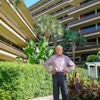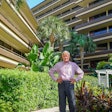After 25 years as a teacher, Cynthia Kanai has embarked on a new challenge: CEO of Ann Norton Sculpture Gardens, a property right next door to her previous workspace at Palm Beach Day Academy. In this new role, Kanai is focusing on connecting with the Gardens’ visitors—more than 5,000 so far this season, 40 percent coming from outside of Florida—and keeping members excited about returning and continuing to bring in students who use the Gardens as a classroom of science, health and art.
You had visited the Gardens previously with students—what’s special about them to you now?
Now that I’m living it every day, I have a new wonder for what an incredible urban oasis it is. It’s just two acres on the Intracoastal that really has been preserved and protected from all the building that is around us. That was really Ann Norton’s legacy, that it be protected and that it be a space for the community to enjoy. I love to get up from my desk and take a walk through the Gardens and see plants changing and growing. We have an incredible collection of palm trees and cycads. I grew up on an Oklahoma farm, and I’ve always been connected to the earth and the plants, so in some ways this is like going back to my roots in my enjoyment of that.
What’s been the biggest challenge so far in this new role?
Thinking about all we want to do for the future. To think strategically about how we can expand our programming and membership—be something like a rainbow of experiences that will connect with lots of different people. We want our community that has never visited the Gardens to be excited about coming and experiencing this; getting the word out to people who maybe have driven by before but have never been inside. Also, for the people who have supported us, to continue to have exciting, fresh exhibitions and interesting speaker series, and wonderful educational opportunities that appeal to a wide range of our members.
How much do you interact with museum members?
That is something I like to spend a good portion of my day on: if we have tour groups, I like to welcome them. If we have a family, I like to catch them on the back side of the garden to say hello. We have recently added a catered lunch in our courtyard, so we now have people coming in for lunch. I love people, so engaging with our visitors is a pretty high priority daily.
How do you keep members excited about coming back?
One of the things we do is change our exhibitions three to four times during the course of the season, to keep our offerings fresh and exciting and on a high level of excellence. In terms of events, in the fall we have what we call Sculpture in Motion, an exhibition of pre- and post-war automobiles. Collectors from all over the country come to have their car displayed. We also had an event this year in December with Iris Apfel, who is a friend of the Ann Norton Sculpture Gardens. We had a dinner with her celebrating her 97th birthday, and we had a book signing. Both of those events appealed to a different sub-group of our community, people that might not have experienced the Gardens that are interested in an event.
What changes are coming to the Gardens?
We have a donor who is going to fund a full-time educator which will help to raise our educational programming to an even higher level. Each year we serve about 5,000 Title I students—we have Literacy Day, and we have a program called Art and Healthy Hearts, where students come in and many times meet the artist in exhibition and hear from that artist what their process is, and what their inspiration has been, and how they’ve changed over the years. We set up spaces in the Ann Norton Studio for these students to create their own pieces of art based on what they’ve heard from the artist. We also work with the American Heart Association to discuss what is healthy for them to eat that is good for their minds and bodies, and we provide rainbow salad for their lunch on that day. We’re doing about 10 of those this year, as well as Garden Day and Earth Day. We’ve done a number of improvements in the Gardens over the last few months. One of the improvements is an outdoor classroom that is going to allow us to expand our environmental science programs, as well as art education and history of this space. We have changed our pathways in the Gardens to be able to accommodate wheelchairs and strollers, so we are going to be opening the Gardens up to a vast array of people who haven’t been able to experience it.
Did you have any museum or art experience prior to taking this position?
No, I didn’t. I had an appreciation for art, but my background is totally about education. In my time as a teacher, I was also director of community service within our school for 20 years, and I was also director of a partnership that we had with China—I did seven trips to China with students. Even though I might not have had direct art and museum experiences, I had a lot of experiences that sort of transcend all the things I’m doing here. I feel like I’m in the right place at the right time for me, and hopefully for this organization as well.















